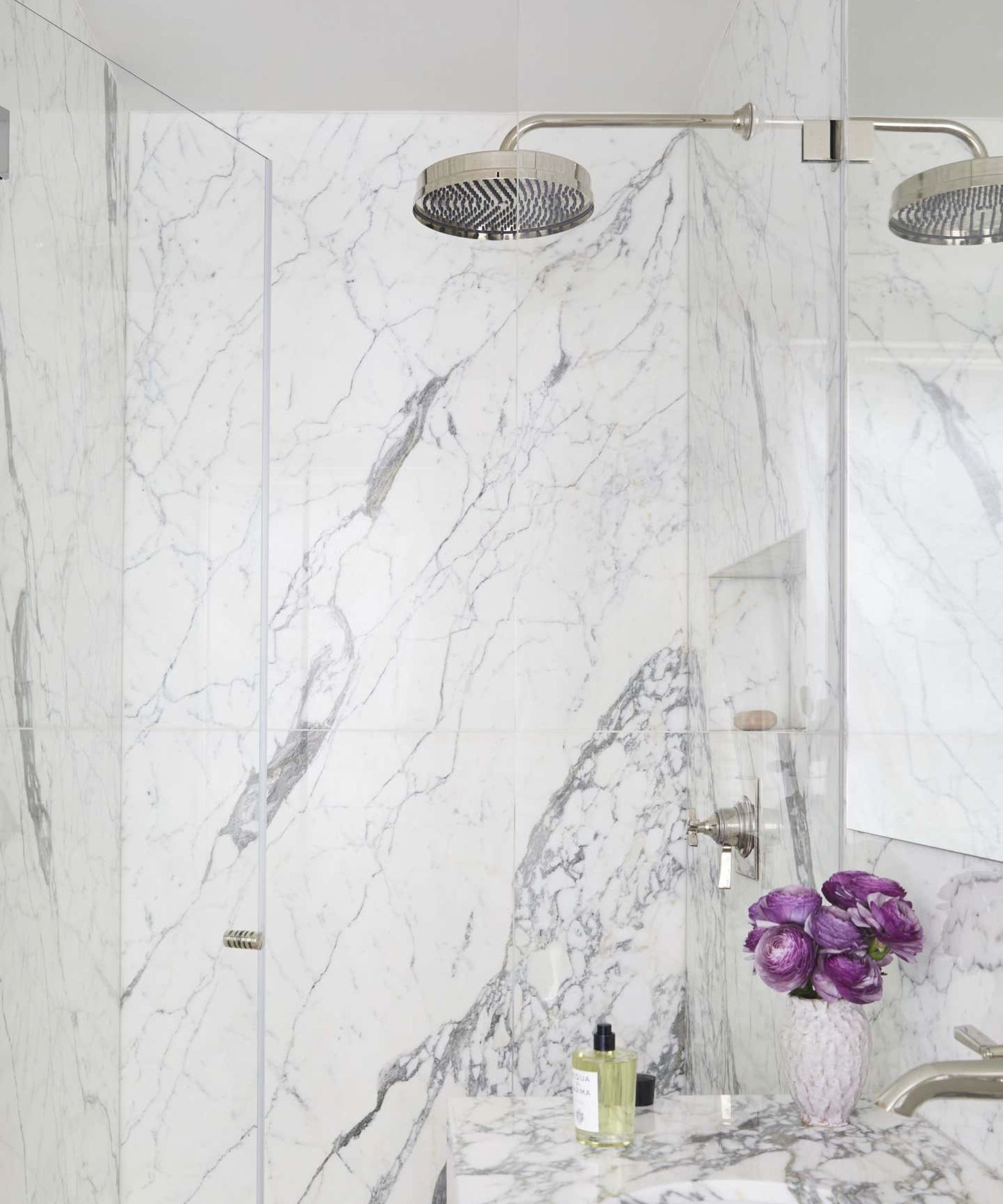How to keep a bathroom warm without heating – 7 ways to keep the space cozy this winter
Experts explain seven ways to make getting out of a warm shower a little more bearable this winter, all without heating
- (opens in new tab)
- (opens in new tab)
- (opens in new tab)
- Sign up to our newsletter Newsletter


While we don’t spend much downtime in our bathrooms, a cold room makes it a lot harder to get out of a steamy shower – especially in winter.
As more people try to save money at home, heating bathrooms is not always at the top of the priority list. If you have been turning your bathroom heating off in favor of warming up your living room more quickly, then finding some ways to harness heat and keep the space comfortable is a great alternative.
Here, experts have explained seven ways to keep a bathroom warm without heating so you can focus your efforts on more livable spaces.
How to keep a bathroom warm without heating in winter
Trying to keep a bathroom feeling warm doesn't have to disrupt your relaxation, here are seven ways to keep your home spa routine intact while staying warm.
1. Keep your bathroom humid to help trap warm air

A bathroom is often one of the most humid areas of a home, and while high humidity can sometimes be a problem inside, higher moisture levels can help to make a bathroom feel warmer without heating. Humidity is excellent for holding heat, so keeping your bathroom steamy, or adding a humidifier or some of the best bathroom plants for high humidity to the space, can actually help to make it feel warmer.
'You might consider snake plants, as they require little maintenance, or eucalyptus as they can be hung in the shower whilst it runs to release essential oils (this also acts as a great decongestant),' suggests James Roberts, director at Sanctuary Bathrooms (opens in new tab). 'A heart-leaf philodendron is also perfect as this plant loves to be kept in damp, humid environments and is great for adding a touch of greenery to your bathroom shelves.'
Be wary of mold developing in high-humidity spaces, however. Most bathrooms will be decorated with tile, or specialized bathroom paint created to resist mold and mildew however excessive levels of moisture can still cause issues. If you suspect your bathroom is starting to suffer from dampness, then reversing the humidification process with a dehumidifier is more advantageous than trying to keep all the heat in all of the time.
2. Add bathroom-suitable window dressings like shutters to stop heat escaping through windows

Adding window dressings to a bathroom is not as simple as hanging up a pair of curtains – especially if you have a small space and the room is particularly moist. Despite this, bathroom window treatments are just as effective in the bathroom as they are when keeping a living room warm without heating. The trick is to use the right materials, such as wooden shutters, to prevent damp fabric.
‘A window dressing in the bathroom such as shutters not only looks great but is a good way to prevent heat loss,’ begins Sam Tamlyn, managing director at California Shutters (opens in new tab). ‘As shutters are fitted bespoke to the window, when their slats are closed, very little air escapes through them, meaning they are great heat insulators, resulting in a warmer bathroom space. Self-install shutters are a great solution to this as they are straightforward to fit and they won’t break the bank.’
'The correct size shutters can prevent over half of all heat lost through windows, keeping cold draughts under control even in older houses,' says Sally Denyer, digital marketing manager, Shutterly Fabulous (opens in new tab). 'Incorporating any style of shutter in a space will help with warmth, but solid wood panel shutters especially are the most effective as they aren’t louvered.’
3. Turn exhaust fans off when not using the shower, especially if it is near the ceiling

Exhaust fans are excellent in drawing excess moisture and steam out of bathrooms after a bath or shower, but they are also pulling warm air out at the same time. Try to avoid using the extractor fan unnecessarily, especially if it is located near to the ceiling where hot air accumulates.
4. Banish drafts in bathrooms with draft proofing strips

While draft excluders and thermal curtains are more suited to keeping an entryway warm without heating, there are ways of easily draft-proofing a bathroom to ensure cold air stays outside.
‘To stop cold air from entering your home, try to block off any particularly colder areas, usually where windows and doors are located. Draft Proof strips or even laying a long pillow or draft excluder directly in front of the open area are just a few cost-effective ways to keep warm air circulating within your home to stay cozy,’ advises Laurence Booth-Clibborn of commercial at-home comforts brand Kudd.ly (opens in new tab).
Trisiki Weather Stripping Door Seal – was $19.99, now $11.98 at Amazon (opens in new tab)
This insulating weather stripping for the door frames and windows is made from high-density CR foam neoprene, which is great for sealing gaps without losing its shape and becoming less effective over time.
5. Use a larger shower head to better disperse warm water

When choosing a shower, the size of a showerhead is probably picked out without much consideration. Although the pressure and look of a showerhead are often more important, changing to a more oversized showerhead that disperses hot water widely will engulf you – and help you to stay warmer in the shower.
6. Introduce soft furnishings to warm and soften the space

Adding soft furnishings to a space is something you might expect to hear more when trying to keep a bedroom warm without heating rather than the bathroom, but layering textiles can have a warming, insulating effect on any space. ‘This time of year bathrooms can be incredibly cold and not inviting! Use as many soft materials as possible to warm the space,’ designer Jemma Paugh of JC Design (opens in new tab) recommends. ‘An oversized bath mat or rug on the floor, curtains or blinds at the windows and turn the lights off and have some cozy candles.’
Hand-Tufted Leighton Bath Mat – $58-78 at Anthropologie (opens in new tab)
Reminiscent of the ocean's shells, this plush bath mat lends your powder room effortless style and comfort.
7. Preheat your towels before bathing

If you are choosing to turn your bathroom heating off in favor of more efficiently heating more regularly used spaces, then preheating your towels in another room can help make getting out of the shower or bath a little more bearable.
What is the most efficient way to heat a bathroom?
The most efficient way to heat a bathroom is to use radiation heaters as opposed to convection. Radiators help to warm objects and surfaces before the air, meaning less warmth is lost through extractor fans and leaky windows than convection heating which simply pushes warm air around the space.
How can I make my bathroom feel warmer?
Layering textiles can help make a bathroom feel warmer. Tiled bathrooms can feel particularly cold, especially when designed with neutral colors or stark whites. Layering bathroom-suitable rugs or mats, plush towels, and gowns will help to soften the space and make it feel warmer.

Chiana is a junior writer for Homes & Gardens having joined Future plc as a new graduate in 2022 after achieving a 1st class degree in Literature at university. She first became interested in design as a child after spending her summers helping her parents redecorate her childhood home. As a long-time reader of Future’s homes titles, Chiana is constantly finding new inspiration at work as she focuses on emerging trends, how-to’s, and news pieces.
-
-
 Robert Pattinson just bought a Spanish Colonial-style home – with an interior designer past
Robert Pattinson just bought a Spanish Colonial-style home – with an interior designer past'The Batman's' Robert Pattinson and Suki Waterhouse purchased the Jeff Lewis-designed Hollywood Hills estate for $5.3 million
By Megan Slack • Published
-
 7 expert-approved methods to remove candle wax from carpet
7 expert-approved methods to remove candle wax from carpetCleaning professionals share their tips on how to remove candle wax from carpet
By Millie Hurst • Published



